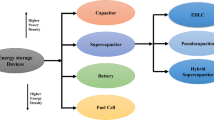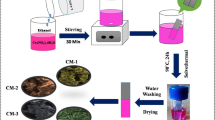Abstract
The polyaniline (PANI) prepared by the pulse galvanostatic method (PGM) or the galvanostatic method on a stainless steel substrate from an aqueous solution of 0.5 mol/l H2SO4 with 0.2 mol/l aniline has been studied as an electroactive material in supercapacitors. The electrochemical performance of the PANI supercapacitor is characterized by cyclic voltammetry, a galvanostatic charge–discharge test and electrochemical impedance spectroscopy in NaClO4 and HClO4 mixed electrolyte. The results show that PANI films with different morphology and hence different capacitance are synthesized by controlling the synthesis methods and conditions. Owing to the double-layer capacitance and pseudocapacitance increase with increasing real surface area of PANI, the capacitive performances of PANI were enhanced with increasing real surface area of PANI. The highest capacitance is obtained for the PANI film with nanofibrous morphology. From charge–discharge studies of a nanofibrous PANI capacitor, a specific capacitance of 609 F/g and a specific energy density of 26.8 Wh/kg have been obtained at a discharge current density of 1.5 mA/cm2. The PANI capacitor also shows little degradation of capacitance after 1,000 cycles. The effects of discharge current density and deposited charge of PANI on capacitance are investigated. The results indicate that the nanofibrous PANI prepared by the PGM is promising for supercapacitors.










Similar content being viewed by others
References
Lin C, Ritter JA, Popov BN (1999) J Electrochem Soc 146:3155
Zheng JP (1999) Electrochem Solid State Lett 2:359
Miller JM, Dunn B, Tran TD, Pekala RW (1997) J Electrochem Soc 144:L309
Conway BE (1991) J Electrochem Soc 138:1539
Conway BE, Birss V, Wojtowicz J (1997) J Power Sources 66:1
Conway BE (1999) Electrochemical supercapacitors: scientific fundamentals and techological applications. Kluwer/Plenum, New York
Zheng JP, Jow TR (1995) J Electrochem Soc 142:L6
Zheng JP, Jow TR (1996) J Power Sources 62:155
Liu KC, Anderson MA (1996) J Electrochem Soc 143:124
Lee HY, Goodenough JB (1999) J Solid State Chem 144:220
Pang SC, Anderson MA, Chapman TW (2000) J Electrochem Soc 147:44
Barsukov V, Chivikov S (1996) Electrochim Acta 41:1773
Belanger D, Ren X, Davey J, Uribe F, Gottesfeld S (2000) J Electrochem Soc 147:2923
Fusalba F, Gouerec P, Villers D, Belanger D (2001) J Electrochem Soc 148:A1
Talbi H, Just P-E, Dao LH (2003) J Appl Electrochem 33:465
Langer JJ, Krzyminiewski R, Kruczynski Z, Gibinski T, Czajkowski I, Framski G (2001) Synth Met 122:359
Hu CC, Chu CH (2001) J Electroanal Chem 503:105
Varela H, Maranhao SLA, Mello RMQ, Ticianelli EA, Torresi RM (2001) Synth Met 122:321
Rudge A, Raistrick I, Gottesfeld S, Ferraris JP (1994) Electrochim Acta 39:273
Ferraris JP, Eissa MM, Brotherston ID, Loveday DC, Moxey AA (1998) J Appl Electrochem 459:57
Laforgue A, Simon P, Sarrazin C, Fauvarque JF (1999) J Power Sources 80:142
Mastragostino M, Arbizzani C, Soavi F (2001) J Power Sources 97–98:812
Frackowiak E, Jurewicz K, Delpeux S, Beguin F (2001) J Power Sources 97–98:822
Rajendra Prasad K, Munichandraiah N (2002) J Electrochem Soc 149:A1393
Jiao SQ, Peng XH, Zhou HH, Chen JH, Kuang YF (2003) Chem J Chin Univ 24:1118
Taberna PL, Simon P, Fauvarque JF (2003) J Electrochem Soc 150:A292
Stilwell DE, Park SM (1988) J Electrochem Soc 135:2254
Morimoto T, Hiratsuka K, Sanada Y (1996) J Power Sources 60:239
Rajendra Prasad K, Munichandraiah N (2002) Electrochem Solid State Lett 5:A271
Hong MS, Lee SH, Kim SW (2002) Electrochem Solid State Lett 5:A227
Lin CQ, Popov BN, Ploehn HJ (2002) J Electrochem Soc 149:A167
Burke AFJ (2000) Power Sources 91:17
Acknowledgements
This work was supported by the National Natural Science Foundation of China (No. 50473022) and the foundation of State Key Laboratory of Chemo/Biosensing and Chemometrics of China.
Author information
Authors and Affiliations
Corresponding author
Rights and permissions
About this article
Cite this article
Zhou, H., Chen, H., Luo, S. et al. The effect of the polyaniline morphology on the performance of polyaniline supercapacitors. J Solid State Electrochem 9, 574–580 (2005). https://doi.org/10.1007/s10008-004-0594-x
Received:
Accepted:
Published:
Issue Date:
DOI: https://doi.org/10.1007/s10008-004-0594-x




